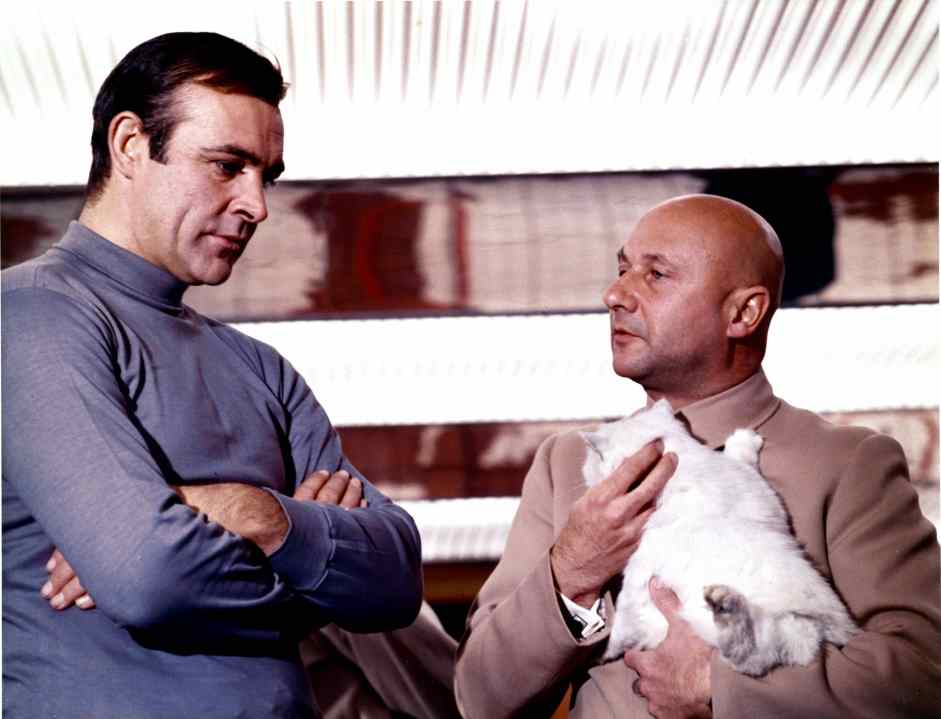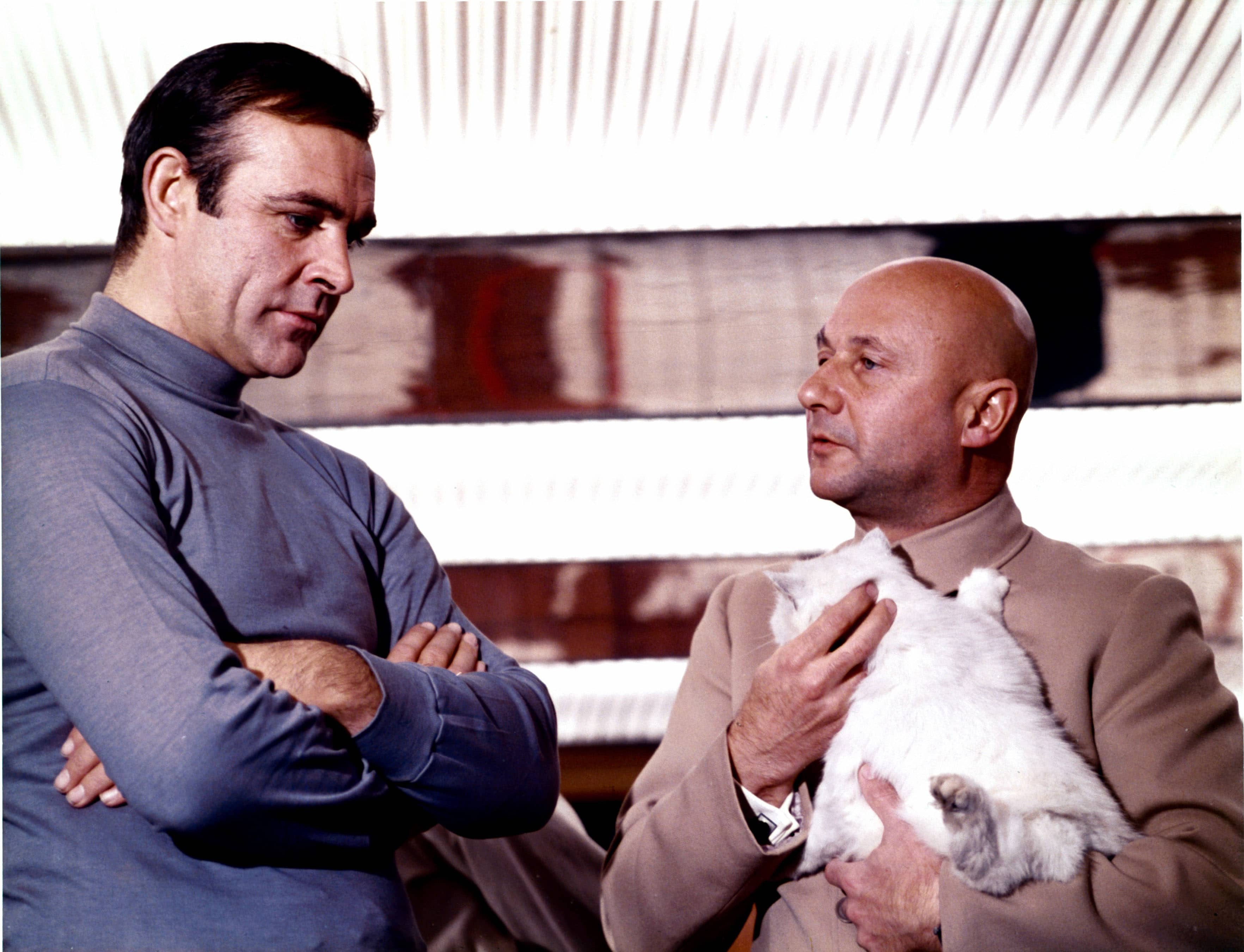Daniel Craig’s fifth and final outing as Bond may not have as many pulses racing due to No Time to Die’s frequently cancelled release dates (the first trailer was back in December 2019), but fans are still keen to see the return of the iconic British spy.
Indeed, recent events have conspired to make 007 more relevant than in previous years, with shiny-pated Amazon boss Jeff Bezos emulating both villains Blofeld (who took over the entertainment assets of billionaire Willard Whyte in Diamonds are Forever) and Hugo Drax (Moonraker) with his recent acquisition of 007 studio MGM and brief space flight.
Until No Time to Die is released, the jury is obviously out on Rami Malek’s (Bohemian Rhapsody) turn as bad guy Lyutsifer Safin (crazy name, crazy guy, as the saying goes), but we know that Christoph Waltz’s Blofeld (Spectre) will be in the picture, ridiculous Freudian backstory and all.
One thing noticeable in the franchise as a whole is the general absence of top-flight female antagonists for Bond. Sure, we’ve had formidable second stringers like knife-booted Rosa Klebb (Lotte Lenya, From Russia with Love), Fatima Blush (Barbara Carrera, Never Say Never Again), Xenia Onatopp (Famke Janssen, Goldeneye) and Pussy Galore (Honor Blackman, Goldfinger), but only The World is Not Enough (1999) boasts a woman as 007’s principal adversary.
The film cast French actress Sophie Marceau as double-dealing oil magnate Elektra King, aided by her rather useless sidekick Renard (Robert Carlyle), unable to feel pain due to a bullet lodged in his brain, rendering him akin to The Black Knight from Monty Python and the Holy Grail (1975).
Perhaps in his next iteration, 007 will face a female (or transgender) mastermind capable of giving the ‘shaken, not stirred’ secret agent a run for his money.
On that note, my selection of Bond’s ten most memorable foes (in no particular order):
The Man with the Golden Gun (1974)
For me, Scaramanga (Christopher Lee) and cheeky Nick Nack (Hervé Villechaize) make an all-time classic double act of Bondian villainy.
Roger Moore’s second time as 007 proved a (relative) financial failure and reviews were lacklustre, possibly as the movie was seen to be aping the kung fu craze of the period.
A shame, as Lee’s three-nippled villain is an impressive opponent, comparing himself to Bond (‘we are the same’) in both his skillset and deadly efficiency.
Scaramanga also possesses the wry sense of humour so missed in many of the modern Bond films, commenting to then superior Hai-Fat on Bond’s escape from a karate school: ‘What do they teach at that academy? Ballet dancing?’
The added value in the picture is provided by Hervé Villechaize’s diminutive sidekick Nick Nack, who enjoys a bantering relationship with his boss and shares an equal dedication to ridding the world of James ‘Herbert’ Bond.
Like Diamonds are Forever’s pervy pair Wint & Kidd, Nick Nack also seemed to be something of a voyeur, but as 007 was always being caught in flagrante, I don’t suppose he minded that much.
Moonraker (1979)
Moonraker is not a great Bond movie by any means, but the late Michael Lonsdale’s poetic Hugo Drax is a wonderful baddie – in fact he’s my favourite of the entire gallery of rogues.
He gets the best lines (‘And you, Dr Goodhead, your desire to become America’s first woman in space will shortly be fulfilled’) and appears a decent employer, boosting the then sagging world economy with his hiring of the unemployed Jaws (Richard Kiel) after Bond killed his previous #1 henchman Chang.
Drax’s strictures about physical perfection rebound on him towards the end of the picture when Jaws and his lady friend Dolly realise that they may not be suitable candidates for the would-be World King’s new Earthly Eden.
The film suffers from its attempt to cash in on the Star Wars craze, upping the global stakes still further after The Spy Who Loved Me (1977).
The gondola chase in Venice is best forgotten, a scene which could easily have been accompanied by the Benny Hill Show theme. The next Bond movie (1981’s For Your Eyes Only) was a conscious attempt to bring the franchise down to earth (sic) with a more realistic (for Bond) premise.
From Russia with Love (1963)
Admittedly, Robert Shaw’s Red Grant is not technically the main villain in From Russia with Love, but he’s a great adversary, one who is no pushover for Connery’s 007. Even if he doesn’t know which wine to serve with fish…
Along with his Nazi Colonel in The Battle of The Bulge (1965) and Henry VIII in A Man for All Seasons (1966), Shaw never looked in better fettle, a stark contrast to his grizzled Quint in Jaws (1975) when he was (shockingly) only 48 years old.
In fact, From Russia With Love is a rarity in having no main villain, with the chores being shared by SPECTRE myrmidons under the orders of #1 (aka Blofeld, played by Anthony Dawson), shown in shadow from the chest down, stroking his customary white moggy.
Goldfinger (1964)
Does portly German golf and card game cheat Auric Goldfinger (Gert Fröbe) remind you of anyone?
Former President Trump (of German ancestry on his father’s side) also shares Auric’s love of gold, as evidenced by the garish decoration of his hostelries and private apartments.
Back to Goldfinger, he’s a rather boorish character, but with an eye for talent, backed up by loyal henchman Oddjob and Pussy Galore’s all-female Flying Circus of pilots, although Galore does rat him out in the end after succumbing to Bonds brutish charms.
Goldfinger’s plan to irradiate Fort Knox to increase the value of his own gold stockpile is a sound one, but (as usual in Bond movies) sloppiness in follow-up work on a captured 007 proves the baddie’s undoing, as he wanders off before a prone 007 is due to be cut in half by a laser beam.
Poor finishing, as TV football pundits are wont to say.
On Her Majesty’s Secret Service (1969)
Prior to his international fame in the 1970s as Greek American lollipop-loving NY detective Theo Kojak, Telly Savalas was perhaps best known as a bad guy in the movies, aided by his trademark shaven head and slightly depraved air.
Telly Savalas is my favourite incarnation of the Bond nemesis Blofeld, closely followed by Donald Pleasence in You Only Live Twice (1967).
He is superb in OHMSS, even though his scheme to blackmail the world through germ warfare to recognise his title as ‘Count Balthazar de Bleuchamp’ does appear to be on the petty side. Much like Dr Evil asking for £1m in the first Austin Powers movie (1997).
Director Peter Hunt’s movie is one of the best in the series, and although former Fry’s Chocolate model George Lazenby is no Connery, he’s convincing in the action sequences.
The Antipodean Lazenby has a decent chunk of his dialogue dubbed by George Baker, as he couldn’t quite nail the accent required for his disguise as College of Arms genealogist Sir Hilary Bray (played by Baker at the beginning of the film).
A View to a Kill (1985)
Looking if anything older than his 57 years (consider that Brad Pitt was just a year younger in 2019’s Once Upon a Time in Hollywood), Roger Moore is a very creaky 007 in his final Bond.
Back in the 2015 BBC documentary Premium Bond, Mark Gatiss (Inside #9) went so far as to comment: ‘If you watched this film, not as a James Bond film, but as a film about an elderly man who thinks he’s a secret agent, it’s absolutely charming.’
Luckily the movie has a decent villain, with Christopher Walken especially good value as Nazi-bred Übermensch Max Zorin. Walken plays the role with a light touch, in some scenes even appearing to wink at the audience. And why not, as the plot is pretty much tripe (something about submerging Silicon Valley)
Tomorrow Never Dies (1997)
‘Let the mayhem begin’ says scheming Murdochian media mogul Elliot Carver (Jonathan Pryce) in Pierce Brosnan’s second Bond movie. Carver’s plan is to start a war between the UK and Communist China in the South China Sea. Why? To sell more papers and increase viewing to his cable news channels of course.
It’s up to Bond to uncover the plot and put paid to Carver; his task complicated by his previous relationship with the billionaire’s trophy wife Paris (Terri Hatcher). Was Tony Blair influenced by the movie or was it vice versa?
Pryce is underrated as the white-wigged Mao-jacket sporting megalomaniac, serving up his dialogue with evident relish: ‘Soon I’ll have reached out to and influenced more people than anybody in the history of this planet, save God himself. And the best he ever managed was the Sermon on the Mount.’
Joe Don Baker (Edge of Darkness) pops up in the movie (and in 1995’s Goldeneye) as CIA liaison Jack Wade; curious since he was the villain Brad Whitaker in The Living Daylights (1987) eight short years earlier.
Quantum of Solace (2008)
The second of the Craig quintet is the shortest Bond picture and one of the most derided on release, not least for its dull title, taken from one of Ian Flemings’ 007 short stories.
But since then, Quantum of Solace has quietly been accruing a reputation as a decent addition to the series.
Following directly on from Casino Royale, the Bourne-style action sees 007 track down heads of the Quantum organisation (a Spectre front), chiefly eco-millionaire Dominic Greene who is busy gaining a monopoly of Bolivian water rights.
Mathieu Amalric (Munich) is good fun as the weaselly Greene, who unfortunately has possibly the lamest sidekick in the franchise – Elvis (Anatole Taubman), whose potential for menace is undercut by his gormless Moe Howard (Three Stooges) bowl cut.
Amalric’s weird squealing during his fight scene with the far beefier Craig is a highlight of the picture.
I do have a problem with Bond’s decision to sling murdered friend/ally René Mathis (the great Giancarlo Giannini) into the nearest refuse skip, rather than arranging for his remains to be sent back to his loving wife in France. ‘He wouldn’t care,’ Bond intones as he dumps the unfortunate Mathis onto a smelly heap of Bolivian garbage. Personally, I think he would.
The Spy Who Loved Me (1977)
Usually acknowledged as the best of the Moore Bonds, TSWLM sees web-handed aquatic wanna-be world dictator Carl Stromberg (Curt Jürgens) attempt to provoke a global nuclear war with the aim of eventually emerging as the head of an underwater empire.
As ambitions go, it’s certainly original, and to be sure, Stromberg’s vision of a marine kingdom ‘Under the Sea’ bears scant comparison to the Little Mermaid’s Atlantica.
The usually sedentary Stromberg is aided in his efforts by towering henchman Jaws (Richard Kiel), who has yet to reveal the softer side he displayed in Moonraker.
Spectacular sets from Ken Adam, a great foil to Bond in Barbara Bach’s Soviet Agent Triple X and Carly Simon’s theme song (Nobody Does it Better) make Spy an enjoyable watch, although the silliness of some of the later Rog entries is foreshadowed by increasingly gimmicky gadgets.
None thankfully in the realm of Die Another Day’s (2002) invisible car though.
Never Say Never Again (1983)
Not an ‘official’ Bond movie, but NSNA boasts a first-class foe in the shape of the jumpy Largo, played by the excellent Klaus Maria Brandauer (Mephisto). Barbara Carrera backs the senior Spectre operative as his equally unhinged henchperson Fatima Blush.
Both roles seem to have been written (or at least performed) as a pair with serious cocaine habits, given the amount of twitching, wild-eyed staring and general tomfoolery going on. Donning the Bond toupée for his final outing, Sean Connery apparently had a miserable time making the film, bringing in sitcom writers Dick Clement and Ian La Frenais (Porridge) to punch up the script.







Comments